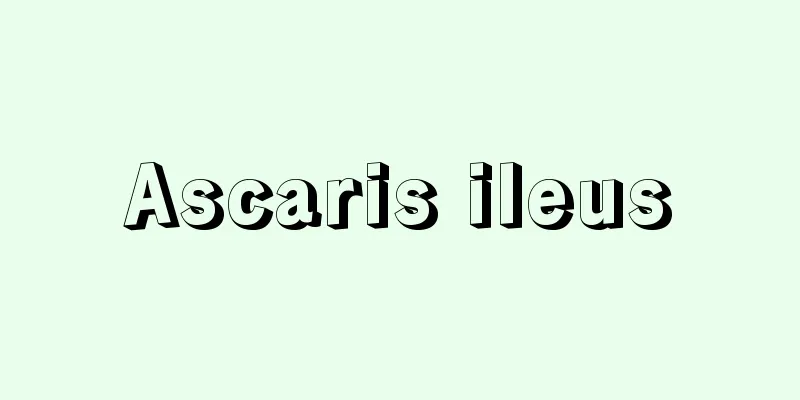Ascaris ileus

|
Ascaris ileus is intestinal blockage caused by the clumping of ascarids in the body. This disease is very serious. People may not know much about it and rarely see such patients. The incidence of ascaris ileus is very high among children. Because children have a high chance of being infected with ascarids, patients will have symptoms of increased body temperature and diarrhea, and must be treated in time. Ascaris intestinal obstruction is more common in children. Children are very easy to be infected with ascaris. This is due to their lack of attention to hygiene. Children always like to suck their fingers and sometimes eat whatever they pick up, which will cause them to be infected with ascaris. Once this disease occurs, it must be treated in time. Clinical manifestations In the early stages, ascariasis intestinal obstruction is usually partial. Symptoms include paroxysmal abdominal pain, bloating, nausea, vomiting, and sometimes vomiting or stooling of roundworms. Abdominal pain is often colicky in nature. During physical examination, there is no obvious tension in the abdominal muscles. Most patients feel a cord-like or sausage-like mass around the navel or in the right lower abdomen. Pressing with fingers can feel unevenness or movement. The mass may move slightly, and complete obstruction may occur in the late stage. The site of obstruction is usually located at the terminal ileum. examine 1. Peripheral blood test and stool test Eosinophilia in peripheral blood. Fecal examination can detect worm eggs in the feces; if only male worms are parasitic, no worm eggs will be found in the feces. 2. X-ray examination The X-ray abdominal plain film images show: ① The obstruction mostly occurs in the lower part of the small intestine, and most of them are incomplete obstructions. ② In the upright abdominal radiograph, wavy or coarse granular uneven shadows with uneven density can sometimes be seen above the fluid level, presenting a typical "hump" sign. ③ Various postures of the worms can be seen on the abdominal films of most patients, some arranged in ropes or curled up into balls, with coarse granular cross-sections of worms of similar sizes, and their shapes are constantly changing. The worm body is 5 to 6 mm thick. If the worm swallows air, linear or dot-like air shadows can be seen in the worm body. If the worm swallows barium, many linear or dot-like barium shadows can be seen after the barium in the patient's intestines is discharged. ④ The worm mass in the intestine can also cause spasm, peristaltic disorder leading to intestinal torsion, and even develop into strangulation and necrosis. ⑤ Ascaris lumbricoides trapped in the ileocecal valve has difficulty passing through due to the spasm of the valve. The clinical manifestations are severe spasmodic pain, and bundles of ascaris lumbricoides can be seen embedded in the ileocecal valve under X-ray. ⑥ If intestinal necrosis and perforation occur, curled ascaris shadows may be seen in the surrounding pneumoperitoneum or abscess air cavity. 3. Ultrasound examination The ultrasound and imaging show : ① The intestinal tube above the obstruction is dilated, the lumen is widened, and liquid and gas accumulate in the lumen. Multiple dilated intestinal tubes that are completely filled with liquid form a multicystic appearance, and liquid flows in the intestinal tubes, with active reflux. In patients with severe obstruction, fluid seeps into the intestinal spaces. ② Ascaris images can be seen in the intestine. A single ascaris appears as a strip with strong echoes, showing its movement in the lumen. Multiple ascaris often aggregate into clusters. When using B-ultrasound to diagnose intestinal obstruction, they can be identified by different acoustic shadows. The effect will be more ideal if it can be complemented by X-ray examination. Symptoms If the ascaris blockage lasts too long, a small number of patients may develop intestinal wall ischemia, necrosis, and perforation, resulting in a large number of ascaris entering the abdominal cavity and causing various complications. treat Most cases of ascariasis intestinal obstruction can be cured through non-surgical treatment. 1. Non-surgical treatment (1) Fasting, continuous gastrointestinal decompression, antispasmodics and analgesia, and correction of water and electrolyte disorders and acid-base imbalance. (2) Patients with mild symptoms and good general condition can take compound acetylsalicylic acid (APC), vitamin C, or oral vinegar. (3) Drug deworming currently uses compound mebendazole (mebendazole), albendazole (enteric worm clearing) and other drugs with satisfactory results. However, some people advocate that anthelmintics should be used with caution before the obstruction is relieved, otherwise it may aggravate the obstruction or increase the possibility of complications. (4) Traditional Chinese medicine (TCM) can be used to clear the interior of the body and attack the lumps of roundworms, such as ginger honey soup and black plum soup. Acupuncture, massage, etc. can also be used to disperse the lumps of roundworms. (5) Oral oils: Oral soybean oil, peanut oil, pepper oil, sesame oil and other vegetable oils. (6) Enema using warm salt water or Dachengqi decoction dripping into the anus or enema can also achieve certain therapeutic effects. Using air or oxygen enema can change the living environment of ascaris, paralyzing the worms and expelling them from the body, but it is contraindicated for patients with intestinal ulcers, intestinal perforation, and the elderly and weak. 2. Surgery If the condition does not improve or worsens after non-surgical treatment, surgical treatment should be performed. During the operation, you should first try to use techniques to squeeze and loosen the roundworm mass and squeeze it into the large intestine, and then perform deworming treatment later. If this fails, intestinal incision should be performed to remove the worms. If there is intestinal necrosis, intestinal resection is required; if the abdominal infection is mild, abdominal lavage may not be required, but if the infection is severe, thorough lavage is required. When the lesion is treated thoroughly, abdominal drainage may not be necessary. Everyone should know some symptoms and treatments of ascariasis intestinal obstruction. Early treatment of the disease is the most important. In daily life, we should also actively control the emergence of infectious sources, especially to develop good personal hygiene habits, especially for children. They should wash their hands before and after meals, and not eat lettuce, and some unwashed carrots, sweet potatoes, etc. |
<<: How to use a light wave oven
>>: Live attenuated poliomyelitis vaccine
Recommend
Nine out of ten women have cervical erosion. What should they pay attention to in order to prevent cervical cancer?
A survey found that about 75% of women suffer fro...
Why does the heart keep beating?
The beating of the heart is the basis for maintai...
Can asthma be contagious?
In fact, many people worry that asthma is contagi...
Si Shen Cong Pain
Si Shen Cong is one of the many acupuncture point...
Why do I sweat yellow
The weather is hot in summer and people often swe...
In addition to the early headache symptoms of nasopharyngeal carcinoma, what other causes are there?
What are the early headache symptoms of nasophary...
Which hospital is good for treating fibroids
Which hospital is good for fibroids? In order to ...
What causes urine to smell like garlic
Urine is the main way for the human body to excre...
Take a break after working out for a few days
In order to achieve the goal of keeping fit and s...
Can charcoal remove formaldehyde?
There are many ways to remove formaldehyde. If yo...
Can glioma be passed down to children?
Children are the hope of a family. For patients w...
How many vitamins should I take to lighten spots
No matter how good-looking you are, a clean face ...
Top 10 symptoms and warning signs of bone cancer in women
The early symptoms of bone cancer in women are us...
Does softening cause great harm to hair?
Softening does not cause too much damage to hair,...
Is banana cold in nature?
For some friends who have poor stomachs, it is be...









